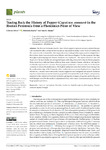Mostrar o rexistro simple do ítem
Tracing Back the History of Pepper (Capsicum annuum) in the Iberian Peninsula from a Phenomics Point of View
| dc.contributor.author | Silvar, Cristina | |
| dc.contributor.author | Rocha, Filomena | |
| dc.contributor.author | Barata, Ana M. | |
| dc.date.accessioned | 2023-02-17T16:47:14Z | |
| dc.date.available | 2023-02-17T16:47:14Z | |
| dc.date.issued | 2022-11-13 | |
| dc.identifier.citation | Silvar, C.; Rocha, F.; Barata, A.M. Tracing Back the History of Pepper (Capsicum annuum) in the Iberian Peninsula from a Phenomics Point of View. Plants 2022, 11, 3075. https://doi.org/10.3390/plants11223075 | es_ES |
| dc.identifier.issn | 2223-7747 | |
| dc.identifier.uri | http://hdl.handle.net/2183/32529 | |
| dc.description.abstract | [Abstract] The Iberian Peninsula was the place where pepper (Capsicum annuum) entered Europe and dispersed to other continents but was also an important secondary center for its diversification. The current work evaluated the phenotypic diversity existing in this region and investigated how that evolved from Capsicum native areas (Mexico and Andean Region). For that purpose, the high-throughput phenotyping tool Tomato Analyzer was employed. Descriptors related to size and shape were the most distinctive among fruit types, reflecting a broad diversity for Iberian peppers. These traits likely reflected those suffering from more intensive human selections, driving the worldwide expansion of C. annuum. Iberian peppers maintained close proximity to the American accessions in terms of fruit phenomics. The highest similarities were observed for those coming from the southeastern edge of the Peninsula, while northwestern accessions displayed more significant differences. Common fruit traits (small, conical) suggested that Portuguese and Spanish landraces may have arisen from an ancient American population that entered the south of Spain and promptly migrated to the central and northern territories, giving rise to larger, elongated, and blocky pods. Such lineages would be the result of adaptations to local soil–climate factors prevailing in different biogeographic provinces. | es_ES |
| dc.description.sponsorship | This research was funded by the Spanish Institute for Agricultural and Food Research and Technology (INIA), co-financed by the European Regional Development Fund (FEDER) (Project RTA2015-00042-C02-02), and by the Xunta de Galicia (Project ED431C 2018/57) | es_ES |
| dc.description.sponsorship | Xunta de Galicia; ED431C 2018/57 | es_ES |
| dc.language.iso | eng | es_ES |
| dc.publisher | MDPI | es_ES |
| dc.relation | info:eu-repo/grantAgreement/MINECO/Plan Estatal de Investigación Científica y Técnica y de Innovación 2013-2016/RTA2015-00042-C02-02/ES | es_ES |
| dc.relation.uri | https://doi.org/10.3390/plants11223075 | es_ES |
| dc.rights | Atribución 4.0 Internacional | es_ES |
| dc.rights.uri | http://creativecommons.org/licenses/by/4.0/ | * |
| dc.subject | Capsicum | es_ES |
| dc.subject | Germplasm diversity | es_ES |
| dc.subject | Landraces | es_ES |
| dc.subject | High-throughput phenotyping | es_ES |
| dc.subject | Tomato Analyzer | es_ES |
| dc.subject | Spain | es_ES |
| dc.subject | Portugal | es_ES |
| dc.title | Tracing Back the History of Pepper (Capsicum annuum) in the Iberian Peninsula from a Phenomics Point of View | es_ES |
| dc.type | info:eu-repo/semantics/article | es_ES |
| dc.rights.access | info:eu-repo/semantics/openAccess | es_ES |
| UDC.journalTitle | Plants | es_ES |
| UDC.volume | 11 | es_ES |
| UDC.issue | 22 | es_ES |
| UDC.startPage | 3075 | es_ES |
| dc.identifier.doi | 10.3390/plants11223075 |
Ficheiros no ítem
Este ítem aparece na(s) seguinte(s) colección(s)
-
GI-GIBE - Artigos [83]






